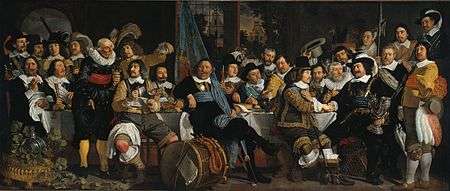Peace of Münster
.jpg)

The Peace of Münster was a treaty between the Dutch Republic and Spain signed on January 30, 1648.[1] It was a landmark treaty for the Dutch Republic and one of the key events in Dutch history; with it, the independence of the United Netherlands was finally recognized by the Spanish crown. The treaty was a part of the Peace of Westphalia which ended both the Thirty Years' War and the Eighty Years' War.
Dutch Revolt
The Dutch Revolt, or Eighty Years' War (1566–1648), was the revolt of the Seven United Provinces of the Netherlands against the Spanish (Habsburg) Empire.
Spain was initially successful in suppressing the rebellion. In 1572, however, the rebels conquered Brielle, and the rebellion resurged. During the revolt the Northern Netherlands became de facto independent and rapidly grew to become a world power through their merchant shipping and experienced a period of economic, scientific, and cultural growth. However at the same time the Southern Netherlands (situated in modern-day Belgium, Luxembourg and Northern France) remained under Spanish rule. Despite various attempts the Dutch never managed to expel the Spanish. In the final years of the war the French allied themselves with the Dutch and they weakened the Spanish in the rear. By 1648 large areas of the Southern Netherlands had been lost to France and despite many military successes Andries Bicker, Cornelis de Graeff and many others wanted to sue for peace.
Negotiations and peace
The negotiations between the fighting parties began in 1641 in the towns of Münster and Osnabrück, in present-day Germany. With the initiation of Spanish-Dutch peace talks, Dutch trade with the Levant and the Iberian Peninsula began to flourish. Dutch merchants, benefiting from both the availability of relatively cheap shipping and the cessation of hostilities, soon dominated the markets that had been previously dominated by English traders. Dutch merchants would also benefit from the foreign upheavals of the English Civil War and gain on English trade in their American colonies.[2]
Despite not formally being recognised as an independent state, the Dutch republic was allowed to participate in the peace talks; even Spain did not oppose this. In January 1646, eight Dutch representatives (two from Holland and one from each of the other six provinces) arrived in Münster to start the negotiations. The Spanish envoys had been given great authority by the Spanish King Philip IV who had been suing for peace for years. On 30 January 1648, the parties reached an agreement and a text was sent to The Hague and Madrid to be signed. On 15 May the same year peace was made. With the peace, the Netherlands was recognized as an independent country.
An original copy of the treaty is held by the Rijksarchief (Dutch national archives) in The Hague.
References
- ↑ https://www.rijksmuseum.nl/en/rijksstudio/timeline-dutch-history/1648-treaty-of-munster Rijks Museum, 1648 Treaty of Munster
- ↑ Gijs Rommelse, "The Role of Mercantilism in Anglo-Dutch political relations, 1650-74", p.596. Economic History Review, New Series, Vol. 63, No. 3 (August 2010), pp. 591-611
Sources
- Boer, H. W. J. de, H. Bruch en H. Krol (red.) Adriaan Pauw (1585–1653); staatsman en ambachtsheer. Heemstede, VOHB, 1985
- Manzano Baena, Laura, "Negotiating Sovereignty: the Peace Treaty of Münster, 1648", History of Political Thought, Volume 28, Number 4, 2007, pp. 617–641.
- Poelhekke, J. J. De vrede van Munster. 's-Gravenhage, Martinus Nijhoff, 1948.